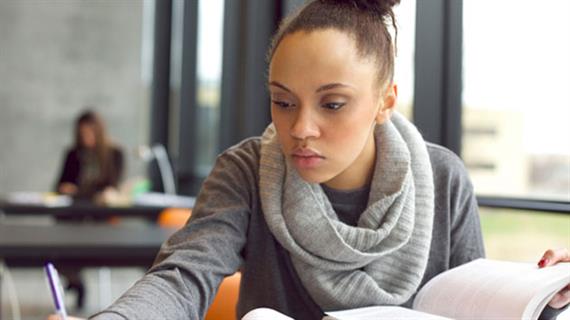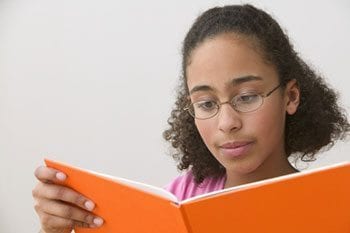How to Teach Students to Close Read

11 Tips to Plow Every Student Into a Shut Reader
By Samantha Cleaver
Let's face information technology, close reading isn't often a skill that comes naturally. When our students get a new reading consignment, their beginning instinct is often to race to the finish line rather than engage securely with a text.
Getting students to slow downwardly, engage with the text in unlike ways, and reflect equally they read are challenges for every teacher, and are the goals of close reading. They're too at the heart of the Common Core English Linguistic communication Arts standards. There's no magic way to turn your class into top-notch readers overnight, but at that place are specific close reading skills you lot tin teach that will assist your students now and downwards the line.
In Harlem, NY, Mark Gillingham, senior researcher with the Swell Books Foundation, watches a group of seventh-grade students reading aloud "The White Umbrella." At one moment the narration becomes unclear and the students brainstorm debating which character is actually speaking. Their genuine involvement in figuring out who is speaking drives them to read, reread, and hash out the section. "This close reading of text that leads to authentic discussion is what the Great Books Foundation wants to cultivate in ALL readers," says Gillingham.
 The primal is learning how to annotate effectively. "When students are drawing conclusions as they annotate their texts, they're using loftier level reading comprehension skills," says Linda Barrett, senior training consultant with the Corking Books Foundation. "Equally their annotation improves, students may begin mark the points when a character makes a determination or when an writer uses a specific literary tool."
The primal is learning how to annotate effectively. "When students are drawing conclusions as they annotate their texts, they're using loftier level reading comprehension skills," says Linda Barrett, senior training consultant with the Corking Books Foundation. "Equally their annotation improves, students may begin mark the points when a character makes a determination or when an writer uses a specific literary tool."
Nurturing these higher-level skills takes fourth dimension and many different techniques. Y'all tin can begin to strengthen close reading in your classroom with these xi practiced tips.
- Exist a Close Reader Yourself
As you teach shut reading, it's of import that you know the text backwards and forwards. Every fourth dimension you raise an issue or ask a question for give-and-take (east.g. "How practise we know that Macbeth feels guilty?"), you lot'll know how to help your students discover the textual evidence and where it's located in the text. Modeling close reading through your grade discussion is equally important as direct education in shut reading. - Teach "Stretch Texts"
The purpose for having students learn close reading skills, says Gillingham, is to enable them to read increasingly circuitous texts over time. Equally you choose texts to use with your students, think about your purpose backside each text. Await for stories or articles that raise authentic questions and could be interpreted differently depending on each educatee's background noesis or prior reading. If you're working with a novel, focus on a section that lends itself to ambiguity and interpretation. And be certain to occasionally assign "stretch texts" in form. These are texts that you wouldn't look students to read independently, such every bit a disquisitional essay or short piece of philosophy. "It'southward a text that'south meant to be difficult," says Gillingham, "and may require up to a week of study." - Teach Students to Await for the Show
If your students leave your class understanding how to provide testify from the text, consider your year an unqualified success. Information technology'southward the most central skill of the Mutual Core standards, says Elfreida Hiebert, president and CEO of Text Project. "The Common Cadre," says Hiebert, "focuses our attention on what content the text is helping united states gain." Push button students to go across recounting facts and plot points. As you're planning, think almost what college club questions you lot tin can ask in class word and written assignments. (Demand help? Hither are some great questions to consider.) - E'er Set a Purpose for Reading
After your students accept read a text through once, help them dig deeper by setting a specific purpose for reading it once more. That purpose could exist to track a concept or theme, or to analyze how an author uses a literary element or creates tone. Giving students something specific to focus on requires that they render to the text and really focus. - Differentiate Your Instruction
Even if students aren't able to shut read a novel independently, they can yet apply strategies to a passage. Students may listen to an oral reading of the text, work in a modest group with teacher support, or piece of work with a partner to reread a text and prepare for discussion. If the majority of your course is non gear up for independent close reading, proceed in mind that the overarching idea is to go students to remember about different ways that people tin interpret text and build their own arguments around text, which tin can exist done with motion-picture show books or read alouds likewise as novels and brusque stories. - Focus on Making Connections
Rather than request students a myriad of comprehension questions, focus their reading experiences around connecting with and remembering the text. Plan and inquire questions that aid you understand if students understand the text, and where they need to dig deeper into the big ideas. Hiebert suggests focusing on how the text relates to what the student has previously read, and what else they might learn virtually the topic later on reading this selection. - Model it First
If students are new to close reading, spend time modeling how to call up well-nigh a prompt and how to annotate the text. You might desire to use a document photographic camera to project pages of the text and read through and comment a passage around a central question, modeling your thinking. Subsequently you do a few pages, release the work to students and have them have the atomic number 82. - Permit Them Brand Mistakes
If some of your students take conspicuously misinterpreted the text, ask them to explain their thinking or help you see the connexion they've fabricated. This gives them a cracking opportunity to practice finding textual bear witness. Students may also chime in with other interpretations. The of import thing is that students clarify and refine their thinking strategies, not that everyone has the same "right" respond. - Shut Read Across the Curriculum
Once students are familiar with close reading in one content surface area, expand the process to other texts and content areas. Close reading tin can happen in science, social studies, math, and other subjects. Students can spend time delving into charts and graphs in scientific discipline, discussing a math concept, or working to truly empathize the diverse interpretations of a speech in social studies. - Use Student Questions to Drive Word
Here's ane technique to consider. During Great Books discussions, teachers start by compiling student and teacher questions that come from the text. Once the questions are compiled in a list, the teacher supports the students in reviewing all the questions, identifying ones that are similar and answering some of the factual questions that only require a short answer. Together, the class discusses the questions and decides which are the virtually interesting and worthy of farther exploration. This is a great style to aid your students learn to ask college-order questions and to write good thesis statements. - Listen to Your Students
Along with close reading the text, yous need to close read your students. When you lot begin to let students' questions and ideas about the text have the lead, you lot'll discover your grade will be much more invested in the reading. Your role will be to keep them grounded to the shut reading process. If a student makes an exclamation, can the course find the textual testify for it? If not, why not? Is a new theory needed? As yous probe into your students' questions, you'll learn more than virtually where your students are and give them opportunities to engage deeper with the text. Ultimately, says Gillingham, "yous are learning everything you can from your students."
How to Teach Students to Close Read
Source: https://www.weareteachers.com/strategies-for-close-reading/